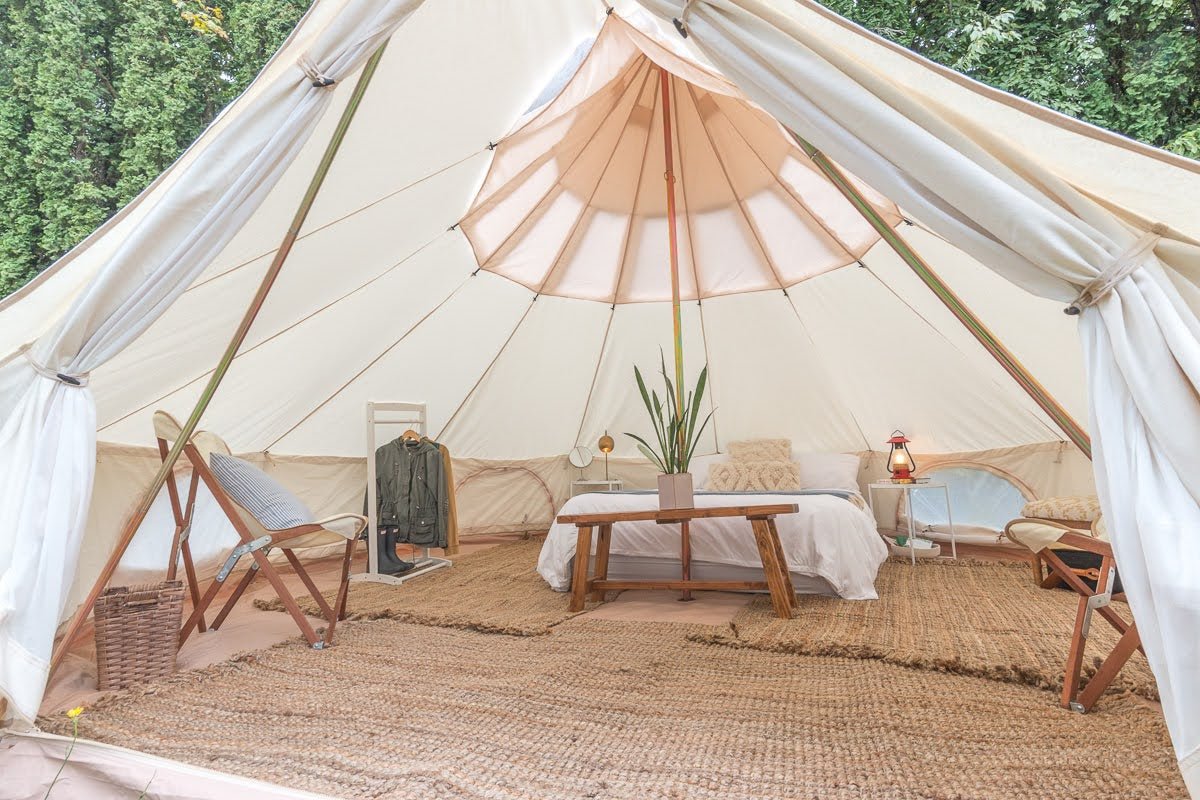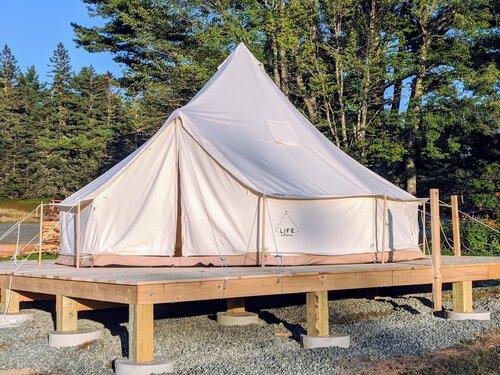NO SALES TAX
FREE TARP WITH TENT PURCHASE
Menu

NO SALES TAX
FREE TARP WITH TENT PURCHASE
Tents
Shop


The LiT List
Glamping & Camping Ideas + Resources
Using a Bell Tent in The Snow: 5 Challenges & Solutions
5 min read 0 Comments
When the winter weather rolls in, it's important to make sure you're prepared with the right gear - including a sturdy and reliable durable 4-season canvas bell tent! A Life Intents bell tent will certainly fit the bill, as our tents are made with extra hefty 11.5oz cotton canvas and are rated to use a wood burning stove. However, even the toughest of tents can be susceptible to problems in heavy winter conditions.
In this article, we'll explain how to use and maintain your camping tent in snow and icy conditions to keep your bell tent from collapsing and to prevent damage. We'll cover the potential problems that can occur when setting up and using your tent in the snow and provide practical solutions on how to prevent or fix them.
Don't let the snow keep you from enjoying your camping trips this winter - read on for some solutions, prevention tips and care instructions that will help ensure a successful trip.
Challenge: Water Damage
Any wet weather can potentially damage your canvas tent, and snow is no exception. Even if your tent was waterproof when you bought it, this protection wears off over time and could eventually expose your tent to mold and mildew or weaken the material as water damage take its toll. If water manages to seep into the canvas material and freeze overnight, it can further damage the material as the water expands into ice.
Solution: Waterproofing Your Canvas Tent
Applying a waterproofing product to your canvas tent might be a good idea before taking it out in the snow. In fact, this should ideally become a part of your regular tent maintenance at least once a year (or more, depending on your climate). A properly waterproofed canvas tent will also help melting snow to more easily roll off your tent.
You can further boost your tent's protection from the elements by using a fly cover over your tent, which not only will help to insulate your tent, but also helps snow to slide off. However, a fly cover generally makes using a wood stove more difficult (unless you exit the stove pipe out through the wall. Additionally, tent rugs are a good way to ensure the inside of your tent remains nice and dry. If melting snow manages to seep into your tent, allow it to dry completely or wipe it up well before packing and storing it to prevent mold or mildew.
Challenge: Snow and Ice Accumulation
Your bell tent's shape can help naturally prevent significant accumulation of snow overhead, but that doesn’t mean it’s immune to a dangerous build-up of snow and ice. It only takes a couple of inches of snow to add over 2,000lbs of weight onto your tent's support structure; that's more than enough weight to cause a bell tent to collapse from a bent or broken pole.
As snow slides, melts and drains off of your bell tent, it can also accumulate around the perimeter of your tent and on the canvas roof eaves. This can lead to the formation of ice dams, which can damage the canvas and make packing up your tent an especially frustrating task.
Image Source: @ownyourglowwellness
Solution: Give Your Tent Extra Support, Care and Warmth
If you're expecting snowy conditions, give your center pole some additional support. There are a few ways you can do this: Wrapping rope around your tent pole can help (and it looks pretty nice, too). But for ultimate strength in the snow, creating a wooden center pole is your best bet. Crafting your own tent pole might sound complicated at first glance, but you can easily make one in just a few steps using this guide.
A wooden center pole will be able to handle a lot more weight than a typical metal tent pole, which can make all the difference during a night of heavy snow. That being said, try to remove any accumulation of snow or ice that you see on your tent when you can. Use a shovel to remove snow and ice around the perimeter of your tent and maintain a freeze-free buffer zone of about two feet. Remove any ice dams on the roof with a stick or broom gently so you do not puncture the canvas in the process.
To further discourage snow and ice from accumulating on your tent, use a heater or woodstove to keep the inside of your tent warm (which is also a great excuse to keep yourself extra cozy). In addition to making your tent more comfortable, this will raise the surface temperature of the canvas and allow snow and ice to melt slide off of your tent rather than building up.
Challenge: Condensation Inside Your Tent
In cold conditions, you might be tempted to keep all the vents and doors shut to keep your tent warm. However, this can cause condensation to build up on the walls and ceiling of your tent. Not only is this a huge pain to deal with, but it can also lead to mold or mildew growth if the condensation isn't able to dry out properly.
Solution: Balance Ventilation and Heat
Ventilation is important for long-term tent care, but you don't have to sacrifice a warm tent to keep air circulating. A proper heater like a tent stove should be able to keep your tent warm (and warm it up rather quickly) even if you need to open a window for better circulation. You can also air out your tent while you plan on being outside, and reheat your tent upon your return.
If you have electricity, a dehumidifier can help remove any moisture in the air, which will prevent condensation. Alternatively, a battery-powered fan can help circulate air more effectively, which can also double as a way to heat your tent more evenly. Lastly, try to avoid storing damp gear or cooking food inside your tent. Both can significantly increase humidity and condensation and reduce the effectiveness of good ventilation.
Challenge: Tent Collapsing While Away
While it may sound convenient to keep your tent up for several days or months during the winter so it’s ready to use when you return from an extended absence, doing so can lead to a disheartening surprise upon your return. Winter weather can easily cause a tent to collapse if you are not monitoring your tent’s condition and addressing the accumulation of snow and ice.
Solution: Remove The Support Poles When You Leave
Ideally, you should pack up your tent completely if you’re not planning on using it for several days in a snow prone region. However, if this doesn't feel practical to you, consider removing all of the support poles and leaving the tent in place. Just be aware that there are a few precautions to take with this approach:
- Pack down any tall and sharp gear that you plan to leave in the tent to discourage the weight of the snow puncturing your canvas.
- Zip all canvas doors closed.
- Completely cover your tent with a tarp. Secure the tarp to keep it from blowing away or uncovering a portion of the tent. Be particularly mindful of covering zippers, windows and doors.
- Wrap your guy line rope sliders to avoid them icing over (if you are keeping the ropes pegged into the ground).
You may need to do a fair amount of snow and ice removal upon your return, so make sure to have the proper tools available (i.e., soft bristle brush, broom, shovel and a good friend).
Conclusion
With a little bit of preparation and proper maintenance, you can easily use your bell tent in all of nature's climates and weather conditions, including freezing snow. Just remember to waterproof your tent, clear away any accumulation of snow or ice, provide additional support to your center pole, and keep the inside of your tent well-ventilated to prevent condensation. By following these simple tips, you can be sure that your next winter adventure doesn't result in any damage to your canvas tent, and that it will keep you warm and cozy all night long.
SHOP OUR 4-SEASON TENTS
Related Resources

THE LIT LIST 4 min read 0 Comments
How to Make Your Tent Smell Fresh After Camping
If you love to camp in tents, there’s nothing better than inhaling that clean mountain air with your
THE LIT LIST 5 min read 0 Comments
Create A Bell Tent Platform Deck
A Life inTents bell tent looks elegant on its own, but placing the tent on wooden platform makes it Popular Blogs
Popular Products
Subscribe
Sign up to get the latest on sales, new releases and tips
BECOME AN INSIDER
We’ll periodically share inspiration, bell tent releases, special offers, and event notifications with ya.

